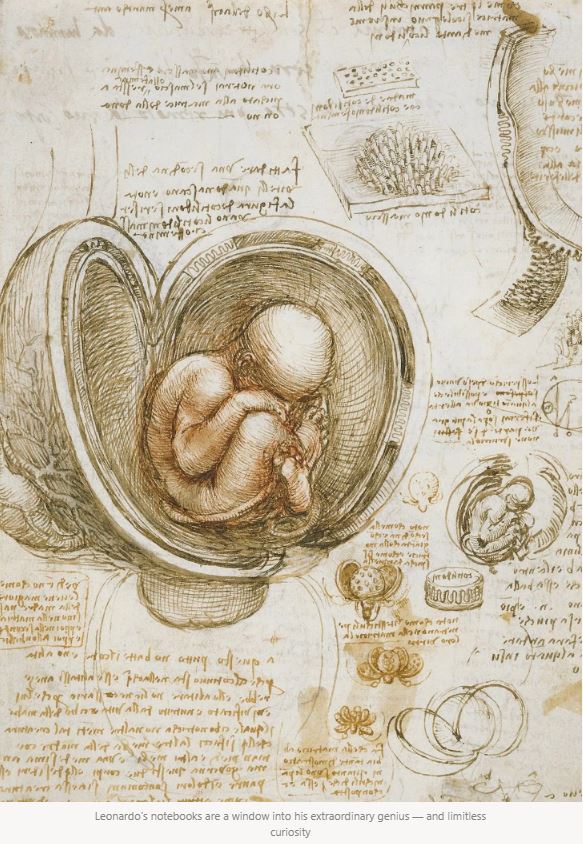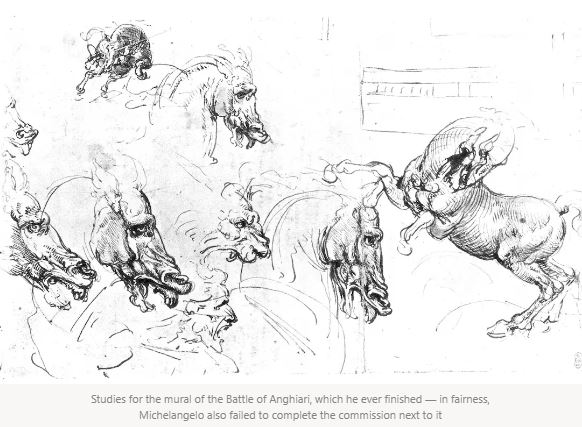“Leonardo da Vinci’s Achilles’ Heel”

And why he thought he was a failure…
The main ingredient behind Leonardo da Vinci’s incredible success can be boiled down to one thing: curiosity. His intense curiosity was the engine of his genius, propelling him to make groundbreaking observations and contributions across various fields.
From anatomy to botany, cartography to engineering, architecture to warfare, his interests knew no bounds. His deep knowledge of these diverse fields allowed him to make connections between seemingly disparate disciplines, and elevate his art in the process.
Leonardo’s notebooks, which contain thousands of pages of sketches and drawings, bear witness to his expansive mind: detailed studies of war machines, architectural plans, rock formations, drapery studies, anatomical dissections, and depictions of natural phenomena like whirlpools.
Unfortunately, this same curiosity was also Leonardo’s Achilles’ heel. The breadth of his interests often prevented him from seeing projects through to completion, as his focus was constantly shifting. The very curiosity that fueled his innovative spirit also scattered his attention, resulting in numerous neglected paintings.
How is it that a Renaissance genius with a career of over 50 years didn’t ever complete more than 20 paintings? Let me explain…
A Story of Two Artists
To preface what’s to come, let’s be clear and affirm that the quality of an artist isn’t measured by the quantity of his artistic output. Painting more doesn’t mean you’re a better painter.
That said, it is true that when compared to the output of his contemporaries, Leonardo’s surviving portfolio is shockingly sparse. Only about 10 completed paintings by da Vinci survive today, and even when accounting for known lost works passed down through copies, the total number of his paintings barely reaches 20. For an artist who spent a lifetime drawing and sketching in his notebook, this is a remarkably low number.
To put this in perspective, consider Leonardo’s contemporary Sandro Botticelli. Sandro and Leonardo were only seven years apart in age, and both grew up in the Palazzo Medici under the patronage of Lorenzo the Magnificent. Botticelli, whose body of work includes the famous paintings The Birth of Venus and La Primavera, completed over 130 paintings in his lifetime.
Botticelli and Leonardo were close friends, despite the fact that the latter wasn’t too fond of the former’s artistic sensibilities. Leonardo frequently critiqued his friend’s work, and famously remarked that Botticelli made “very dull landscapes.” Had Botticelli ever caught wind of this, one can only imagine his retort: “Well, at least I make them!”
External Factors
When Leonardo wasn’t busy criticizing other artists, he was often traveling — a fact that certainly contributed to his inability to complete many projects. Throughout his life, Leonardo moved between Florence, the Papal States, the Republic of Venice, and the Duchy of Milan, among other places.
Each relocation brought both new opportunities and new distractions, making it difficult for him to maintain continuity in his work. These frequent moves were often driven by the need for patronage, political instability, or personal safety, further complicating his ability to see projects to fruition.
Additionally, geopolitical events in the unstable Italian peninsula often interfered with his more ambitious projects. Take for example his unrealized equestrian statue, commissioned by the Duke of Milan.
Leonardo labored for over a decade designing and preparing this colossal bronze sculpture of a horse, which was intended to be the largest in the world. However, due to the Italian Wars, the bronze meant for the statue was repurposed for cannon making, and the project had to be abandoned. Leonardo’s clay model was eventually destroyed by French soldiers (who used it as target practice), and the project was unequivocally consigned to the trash heap of history.
Who was Leonardo’s harshest critic? Himself, of course.
So here are the immensely harsh words he had to say about his own career — and what we can learn from them…
Continue Reading
Pre-Order The Pfizer Papers Book
Become a DailyClout Member
One of our country’s most important freedoms is that of free speech.
Agree with this essay? Disagree? Join the debate by writing to DailyClout HERE.







NICE ARTILCE